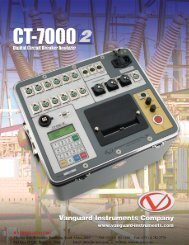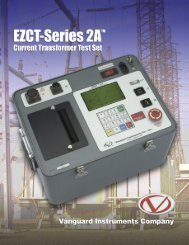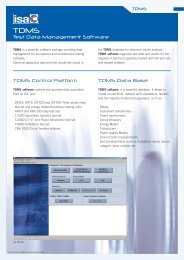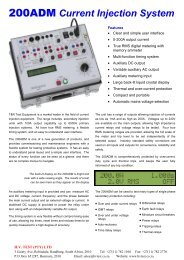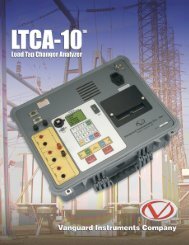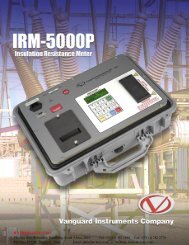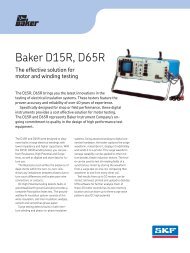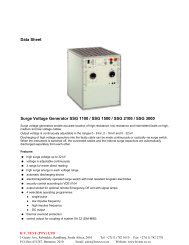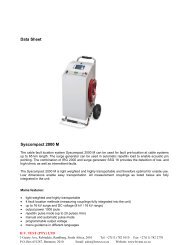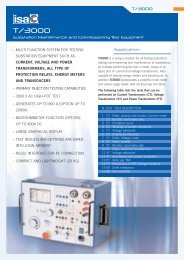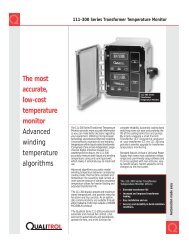POWER TRANSFORMER FREQUENCY RESPONSE ... - afra nojan
POWER TRANSFORMER FREQUENCY RESPONSE ... - afra nojan
POWER TRANSFORMER FREQUENCY RESPONSE ... - afra nojan
Create successful ePaper yourself
Turn your PDF publications into a flip-book with our unique Google optimized e-Paper software.
®<br />
<strong>POWER</strong> <strong>TRANSFORMER</strong><br />
<strong>FREQUENCY</strong> <strong>RESPONSE</strong> ANALYSIS<br />
TEST SET<br />
MODEL FRA-100<br />
The PHENIX Technologies model FRA-100 Frequency Response Analysis test system is a portable,<br />
off-line system designed to detect winding movements resulting from shipping damage, subjection to<br />
low impedance through faults, or general looseness of clamping structures brought on by the normal<br />
effects of aging, in distribution and power transformers. The technology used in this highly sophisticated<br />
diagnostic tool was developed in the United States by the National Electric Energy Testing, Research and<br />
Applications Center (NEETRAC), a center of Georgia Institute of Technology. PHENIX Technologies<br />
and NEETRAC have teamed together to bring this powerful testing technique to the electric power<br />
industry.<br />
EXPERIENCE . . . QUALITY . . . RELIABILTY<br />
20501
THEORETICAL BACKGROUND:<br />
The test is accomplished through the application<br />
and subsequent analysis of a series of low voltage<br />
impulses of varying duration, and approximately 300<br />
V magnitude. Based on the resulting current impulse<br />
measured by the current probe, the frequency response<br />
is calculated for frequencies up to 5 MHz. This<br />
technique is designed to detect winding shifts through<br />
non-destructive methods, and can either be used as a<br />
stand alone test to detect winding damage, or as a<br />
diagnostic tool to pinpoint damages discovered in other<br />
test results such as insulation power factor tests,<br />
dissolved gas analysis, or short circuit impedance.<br />
The testing software provided calculates objective<br />
estimates of the degree of movement based on two<br />
different patented analysis techniques, the Weighted<br />
Normalized Difference (WND) number is used in<br />
analysis of all types of transformers, and the Objective<br />
Winding Asymmetry (OWA) percentage, for use<br />
especially on three phase transformers and single phase<br />
identical sister units.<br />
Basic WND analysis allows comparison to<br />
previous FRA “fingerprints”, baseline data that may<br />
have been made on the transformer at the factory, or at<br />
an earlier date in the substation. This alone can be used<br />
as an effective technique to detect winding damages.<br />
The more advanced OWA technique has been<br />
developed especially for use in cases where no baseline<br />
data exists, but a condition assessment of the<br />
mechanical integrity of the windings is still required.<br />
This technique may be used very effectively in cases<br />
both with and without baseline data to detect and<br />
pinpoint damages to a specific phase and winding. This<br />
is accomplished through an objective (numerical)<br />
comparison of the three individual phase responses<br />
against each other, and a knowledge of the fact that<br />
while the individual phase responses of a three phase<br />
transformer are not identical, they should differ from<br />
each other in a predictable manner based on the<br />
symmetrical design and construction of the<br />
transformer.<br />
Even though the OWA test method has been<br />
shown to be very successful in locating mechanical<br />
winding shifts without historical data, development<br />
testing has shown that the most sensitive indicator of<br />
winding damage may result from the combination of<br />
the OWA test and the historical comparison.<br />
Comparison of a previous OWA test result to a present<br />
OWA test result on a given transformer provides a<br />
means of comparing differences in the frequency<br />
response records obtained from the same transformer<br />
at different times that is largely unaffected by variables<br />
such as temperature and oil condition, since changes<br />
in these parameters have a common influence on the<br />
phase-to-phase frequency response comparison.<br />
Extensive development testing has been done<br />
over a wide range of transformers in the power range<br />
of a several hundred kVA distribution transformers<br />
through several hundred MVA Class I, Class II<br />
substation and generator step up transformers to<br />
determine the evaluation criteria used in the PHENIX<br />
Technologies FRA-100 system. The OWA technology<br />
has been the only technology to date that has shown<br />
the ability to detect and locate problems on<br />
transformers even after they have been de-tanked, and<br />
have had their leads cut and bushings removed!<br />
Typical 3-Phase Transformer<br />
Transfer Function Plots with<br />
OWA Results Displayed
HARDWARE:<br />
System Power Requirements<br />
Battery Operated for Onsite Use<br />
100 to 240 VAC, 50 or 60 Hz source for charging<br />
Digitizer Data<br />
Resolution: .................................... 12 bit<br />
Number of Channels: .................... 2<br />
Sampling Rate (per Channel) ........ 50Ms/sec<br />
Lap Top PC (included)<br />
Processor: ...................................... Intel Pentium<br />
Operating System: ......................... Windows<br />
Monitor: ........................................ Color LCD<br />
Compact Disc Drive: ..................... CDRW<br />
Power Supply: ............................... 100 to 240 VAC,<br />
50 or 60 Hz, with<br />
internal battery for<br />
on site use<br />
Current Probe<br />
Type: .............................................. Low Inductance<br />
Shunt<br />
Resistance: ..................................... 10 Ω<br />
Test Leads<br />
All required test leads and clamps are provided, with pulse<br />
output and signal measuring leads provided in 60 Ft lengths.<br />
This allows the test technician to locate the PC and pulse<br />
source at ground level while performing the test.<br />
DIMENSIONS AND WEIGHTS:<br />
FRA-100 Pulse Source with Digitizer<br />
14" W x 11" D x 6½" H; 21 lbs.<br />
Laptop Computer<br />
13" W x 11" D x 1½" H; 8 lbs.<br />
Cable Lead Bag<br />
19" W x 10" D x 10" H; 17 lbs.<br />
IMPULSE SOURCE:<br />
An internal 300 V impulse source provides the exciting<br />
impulses required for the FRA test. The pulse source is<br />
automatically controlled by the PC, with all pulse<br />
application and data collection being managed by the test<br />
computer, following an initiation command by the test<br />
technician to acknowledge that the test leads have been<br />
connected to the proper terminals of the transformer, and<br />
that all personnel are clear of the test leads.<br />
For each connection configuration, the PC will collect<br />
data from a series of ten applied impulses. Each impulse is<br />
of approximately 300 V magnitude, with a steep rise time<br />
on the order of a few hundred nanoseconds, and a variable<br />
time to chop that is controlled by the test set computer that<br />
ranges over a time interval of approximately 10 to 90<br />
microseconds during the series of 10 applied impulses.<br />
“FRA-100 Test System Components”<br />
Note: Due to continual development, specifications are<br />
subject to change without notice.
SOFTWARE ANALYSIS AND DATA<br />
MANAGEMENT PACKAGE<br />
The FRA-100 software package is a Windows based<br />
application that provides both testing control as well as data<br />
management functions.<br />
Upon selecting the type of transformer from a list of<br />
standard single phase, three phase and auto connections,<br />
the software provides prompts to the user to connect the<br />
leads and initiate each sequence of impulses. Built in safety<br />
checks will prompt the user if there is a problem with the<br />
lead connection that is recognized by the computer, based<br />
on the data collected.<br />
In addition, on three phase transformers the test<br />
technician can select whether or not he or she wants to<br />
perform an OWA test on the transformer. The OWA test is<br />
recommended on all three phase transformers even if a<br />
comparison to historical data is also desired. The OWA test<br />
has been shown to be generally the most sensitive to actual<br />
mechanical changes in the winding geometry, while at the<br />
same time looking over changes that commonly affect all<br />
three phases, resulting from temperature differences, oil<br />
condition, etc.<br />
The data management portion of the software provides<br />
for convenient storage and retrieval of test records, allowing<br />
the comparison of both WND results and OWA results on<br />
any two transformer test records that are selected. This<br />
allows comparison between historical data and present data,<br />
as well as comparison with the frequency response of sister<br />
units if it is desired to make this comparison.<br />
COMPANY PROFILE<br />
Main Test Screen Shot<br />
A test report can be generated and stored that provides<br />
the results of the comparison of any two test records selected,<br />
and that provides written application guidelines that prompt<br />
the test technician about possible reasons for the results<br />
obtained, based on the type of transformer and the results<br />
encountered. The guidelines are based on the extensive<br />
development investigations performed during the development<br />
of the FRA-100 test system, and provide valuable insight into<br />
the results. Additionally, the software generates a Green/<br />
Yellow/Red condition assessment as an immediate visual<br />
indication to the test technician of whether a significant change<br />
exists between frequency responses under comparison. This<br />
visual condition assessment can be used as the basis in<br />
deciding whether additional electrical tests or internal visual<br />
inspections should be made on the transformer before<br />
approving it to be energized in service.<br />
PHENIX TECHNOLOGIES is a leading manufacturer of high voltage, high current, and high power test systems<br />
and components. Our test systems are in operation around the world satisfying the testing requirements of our customers.<br />
Our 65,000 square foot headquarters is a modern manufacturing facility where all the major components of our<br />
systems are produced. All aspects of electrical and mechanical design, software design and actual production are performed<br />
in this facility and controlled by an ISO9001 quality program. Our engineers offer a unique blend of theoretical knowledge<br />
and practical experience. Our ever-expanding Service & Calibration Department stands ready to assist you during and<br />
after installation to insure years of trouble free service.<br />
Our engineering resources, manufacturing capability and commitment to flexibility have earned us the reputation as<br />
the supplier of choice. From portable test equipment to large, cutting edge automated test systems, PHENIX Technologies<br />
provides solutions for your testing needs. You owe it to yourself to discuss your testing requirements with PHENIX<br />
Technologies today.<br />
Your Local Representative is:<br />
®<br />
4/05 © Copyright—Phenix Technologies, Inc., 2004. All rights reserved<br />
75 Speicher Drive<br />
Accident, MD 21520 USA<br />
Tel: 301-746-8118 • Fax: 301-895-5570<br />
e-mail: info@phenixtech.com<br />
http://www.phenixtech.com



